Payroll Department Merger Project: Pretty Me Company & Impact Fashions
VerifiedAdded on 2023/06/10
|24
|5595
|227
Project
AI Summary
This project simulates the payroll merger between Pretty Me Company Ltd and Impact Fashions, examining current payroll costs, and the impact of the merger on those costs. It involves analyzing key performance indicators (KPIs) to develop a merger project plan, addressing challenges, and improving performance. The report assesses project activities, compares savings, and explores staff implications, identifying and mitigating risks. Specific activities include evaluating project activities, comparing pre- and post-merger costs, staff implications, risk identification, and recommendations for a successful merger. Pretty Me, with 39 clothing shops and 500 employees, merges its payroll with Impact Fashions, which has 36 shops and 360 employees. The project, due July 23, 2018, addresses errors and fraud identified in Impact Fashions' audit. The report also includes a literature review on payroll mergers, project management methodologies, a communication plan, and a Gantt chart for project management and timelines.
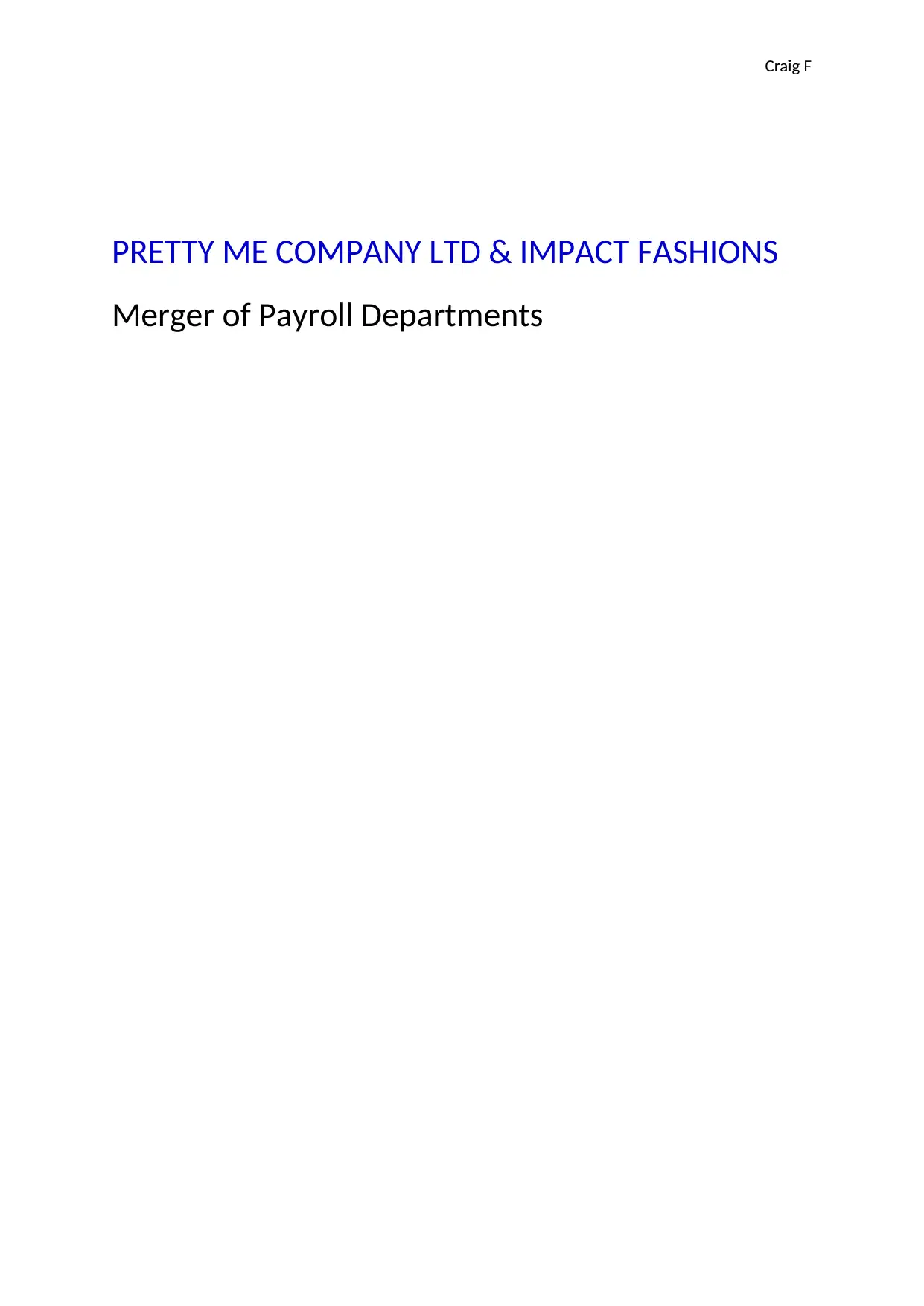
Craig F
PRETTY ME COMPANY LTD & IMPACT FASHIONS
Merger of Payroll Departments
PRETTY ME COMPANY LTD & IMPACT FASHIONS
Merger of Payroll Departments
Paraphrase This Document
Need a fresh take? Get an instant paraphrase of this document with our AI Paraphraser
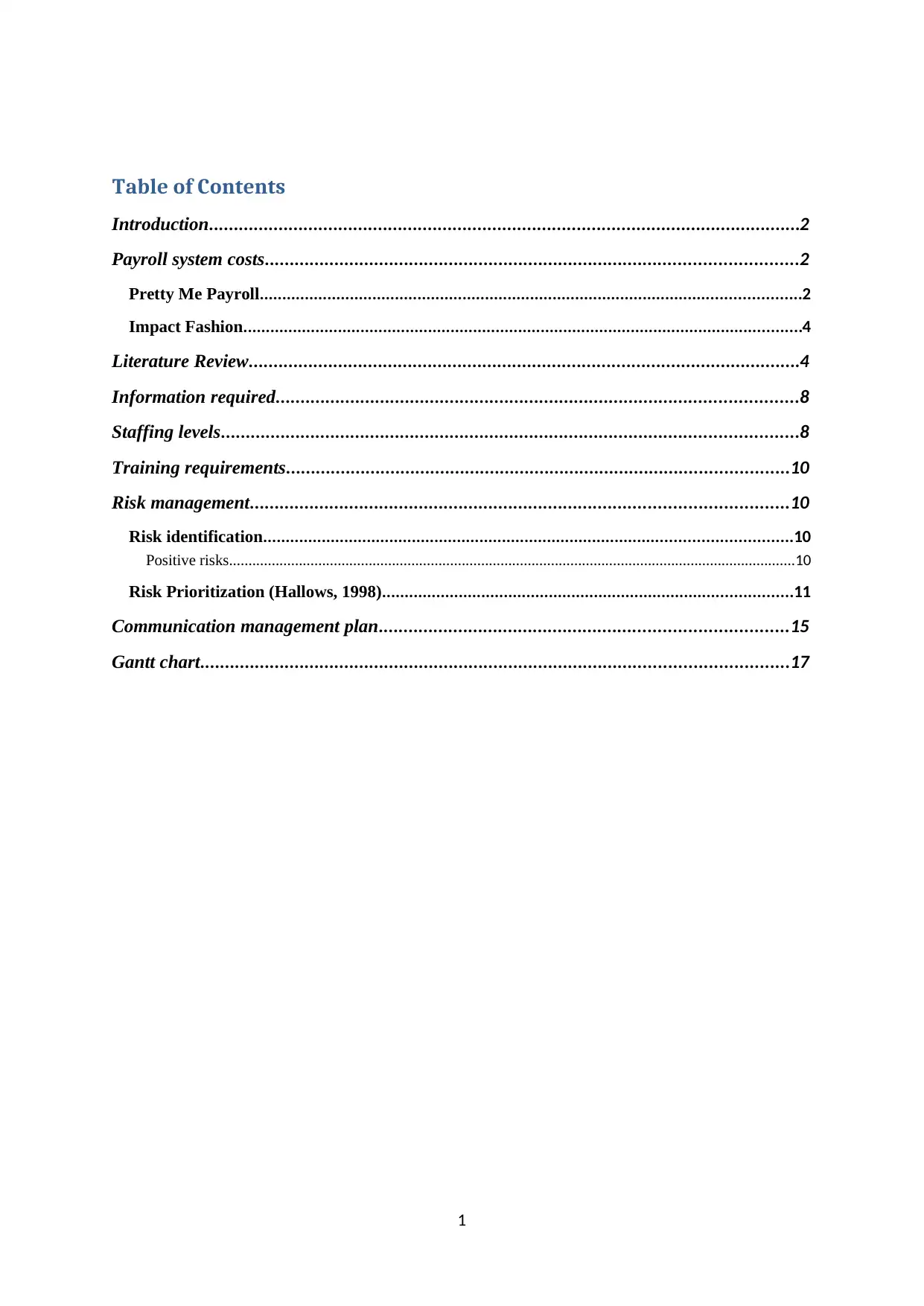
Table of Contents
Introduction.......................................................................................................................2
Payroll system costs...........................................................................................................2
Pretty Me Payroll........................................................................................................................2
Impact Fashion............................................................................................................................4
Literature Review...............................................................................................................4
Information required.........................................................................................................8
Staffing levels....................................................................................................................8
Training requirements.....................................................................................................10
Risk management............................................................................................................10
Risk identification.....................................................................................................................10
Positive risks..................................................................................................................................................10
Risk Prioritization (Hallows, 1998)...........................................................................................11
Communication management plan..................................................................................15
Gantt chart......................................................................................................................17
1
Introduction.......................................................................................................................2
Payroll system costs...........................................................................................................2
Pretty Me Payroll........................................................................................................................2
Impact Fashion............................................................................................................................4
Literature Review...............................................................................................................4
Information required.........................................................................................................8
Staffing levels....................................................................................................................8
Training requirements.....................................................................................................10
Risk management............................................................................................................10
Risk identification.....................................................................................................................10
Positive risks..................................................................................................................................................10
Risk Prioritization (Hallows, 1998)...........................................................................................11
Communication management plan..................................................................................15
Gantt chart......................................................................................................................17
1
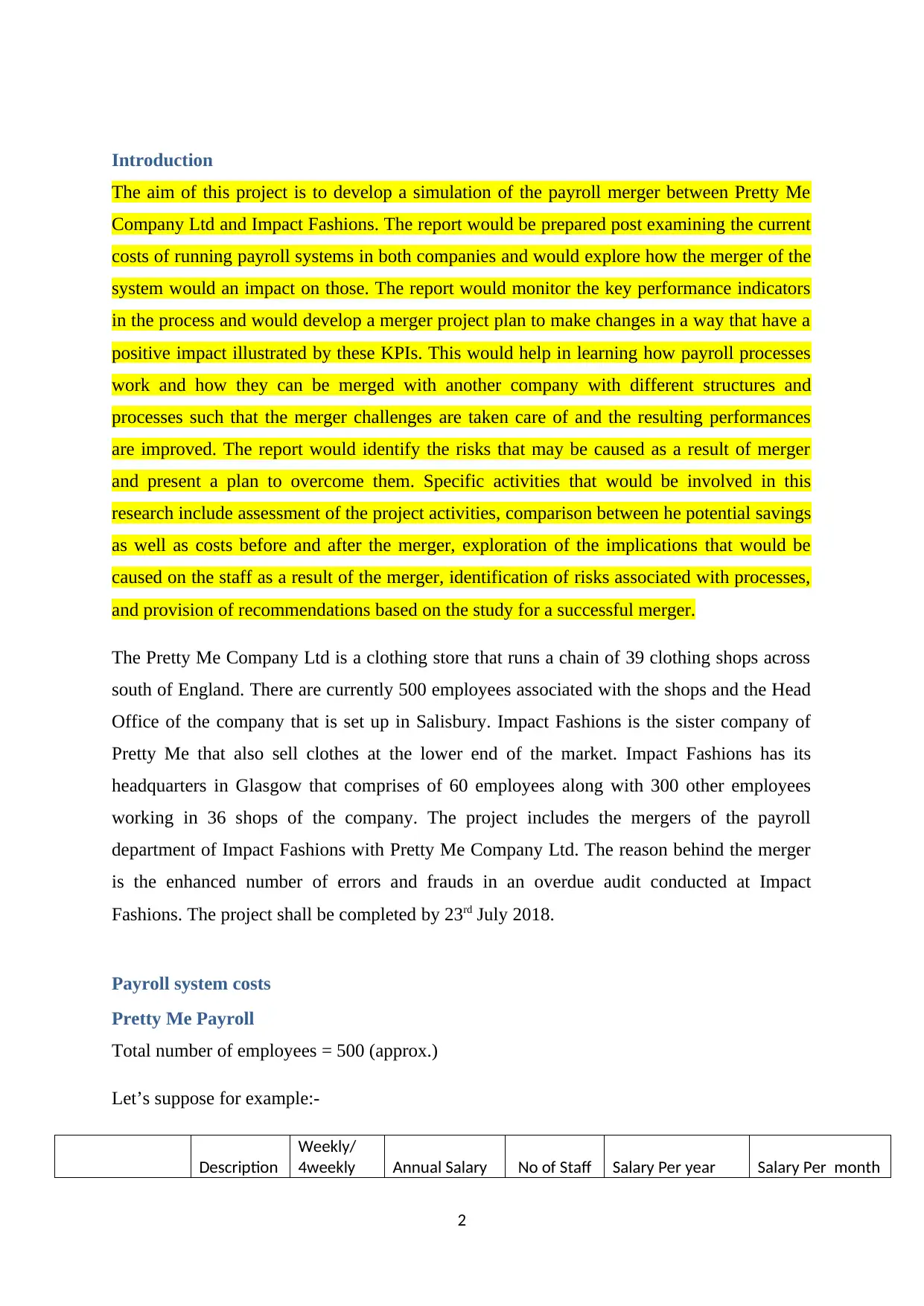
Introduction
The aim of this project is to develop a simulation of the payroll merger between Pretty Me
Company Ltd and Impact Fashions. The report would be prepared post examining the current
costs of running payroll systems in both companies and would explore how the merger of the
system would an impact on those. The report would monitor the key performance indicators
in the process and would develop a merger project plan to make changes in a way that have a
positive impact illustrated by these KPIs. This would help in learning how payroll processes
work and how they can be merged with another company with different structures and
processes such that the merger challenges are taken care of and the resulting performances
are improved. The report would identify the risks that may be caused as a result of merger
and present a plan to overcome them. Specific activities that would be involved in this
research include assessment of the project activities, comparison between he potential savings
as well as costs before and after the merger, exploration of the implications that would be
caused on the staff as a result of the merger, identification of risks associated with processes,
and provision of recommendations based on the study for a successful merger.
The Pretty Me Company Ltd is a clothing store that runs a chain of 39 clothing shops across
south of England. There are currently 500 employees associated with the shops and the Head
Office of the company that is set up in Salisbury. Impact Fashions is the sister company of
Pretty Me that also sell clothes at the lower end of the market. Impact Fashions has its
headquarters in Glasgow that comprises of 60 employees along with 300 other employees
working in 36 shops of the company. The project includes the mergers of the payroll
department of Impact Fashions with Pretty Me Company Ltd. The reason behind the merger
is the enhanced number of errors and frauds in an overdue audit conducted at Impact
Fashions. The project shall be completed by 23rd July 2018.
Payroll system costs
Pretty Me Payroll
Total number of employees = 500 (approx.)
Let’s suppose for example:-
Description
Weekly/
4weekly Annual Salary No of Staff Salary Per year Salary Per month
2
The aim of this project is to develop a simulation of the payroll merger between Pretty Me
Company Ltd and Impact Fashions. The report would be prepared post examining the current
costs of running payroll systems in both companies and would explore how the merger of the
system would an impact on those. The report would monitor the key performance indicators
in the process and would develop a merger project plan to make changes in a way that have a
positive impact illustrated by these KPIs. This would help in learning how payroll processes
work and how they can be merged with another company with different structures and
processes such that the merger challenges are taken care of and the resulting performances
are improved. The report would identify the risks that may be caused as a result of merger
and present a plan to overcome them. Specific activities that would be involved in this
research include assessment of the project activities, comparison between he potential savings
as well as costs before and after the merger, exploration of the implications that would be
caused on the staff as a result of the merger, identification of risks associated with processes,
and provision of recommendations based on the study for a successful merger.
The Pretty Me Company Ltd is a clothing store that runs a chain of 39 clothing shops across
south of England. There are currently 500 employees associated with the shops and the Head
Office of the company that is set up in Salisbury. Impact Fashions is the sister company of
Pretty Me that also sell clothes at the lower end of the market. Impact Fashions has its
headquarters in Glasgow that comprises of 60 employees along with 300 other employees
working in 36 shops of the company. The project includes the mergers of the payroll
department of Impact Fashions with Pretty Me Company Ltd. The reason behind the merger
is the enhanced number of errors and frauds in an overdue audit conducted at Impact
Fashions. The project shall be completed by 23rd July 2018.
Payroll system costs
Pretty Me Payroll
Total number of employees = 500 (approx.)
Let’s suppose for example:-
Description
Weekly/
4weekly Annual Salary No of Staff Salary Per year Salary Per month
2
⊘ This is a preview!⊘
Do you want full access?
Subscribe today to unlock all pages.

Trusted by 1+ million students worldwide
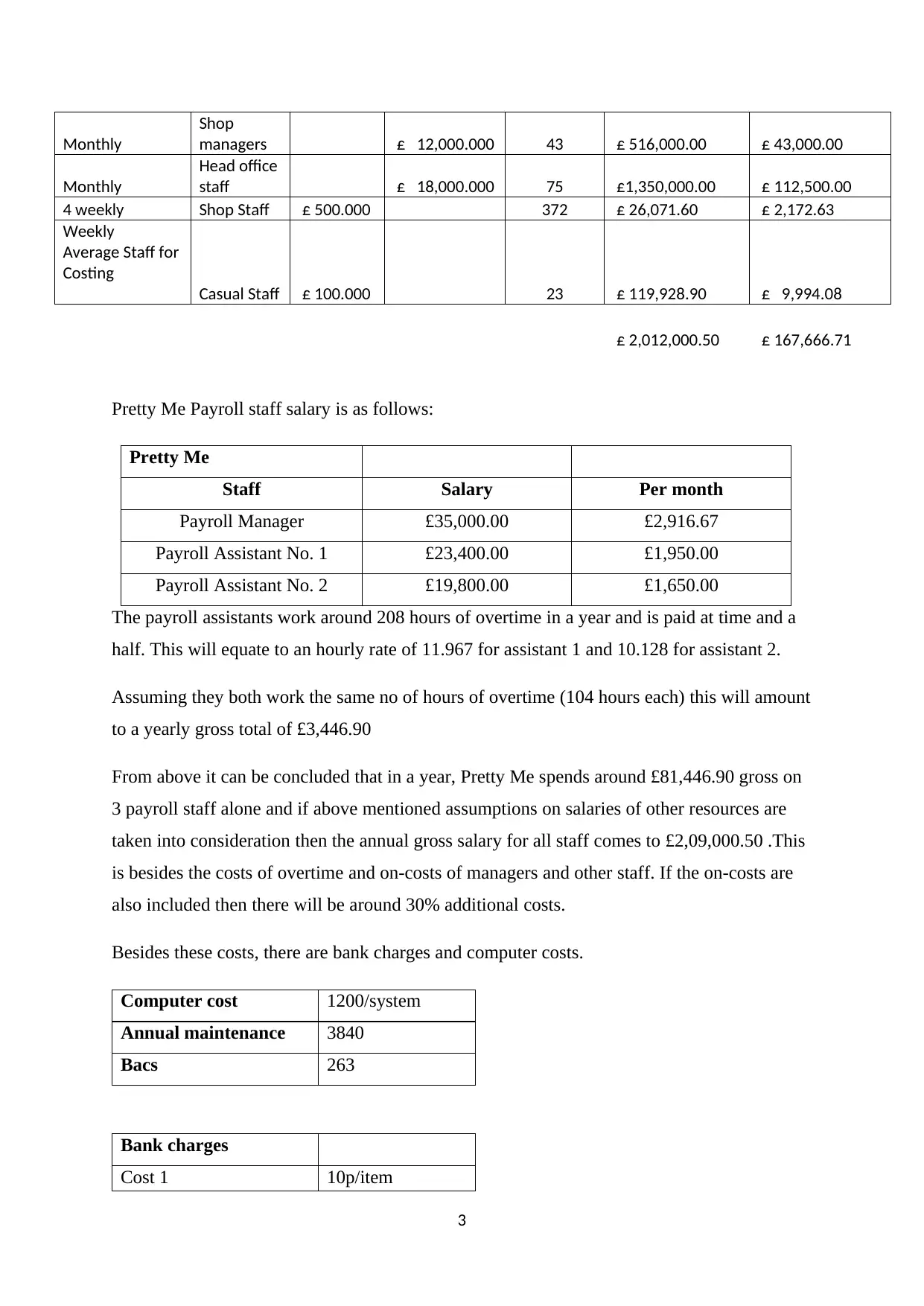
Monthly
Shop
managers £ 12,000.000 43 £ 516,000.00 £ 43,000.00
Monthly
Head office
staff £ 18,000.000 75 £1,350,000.00 £ 112,500.00
4 weekly Shop Staff £ 500.000 372 £ 26,071.60 £ 2,172.63
Weekly
Average Staff for
Costing
Casual Staff £ 100.000 23 £ 119,928.90 £ 9,994.08
£ 2,012,000.50 £ 167,666.71
Pretty Me Payroll staff salary is as follows:
Pretty Me
Staff Salary Per month
Payroll Manager £35,000.00 £2,916.67
Payroll Assistant No. 1 £23,400.00 £1,950.00
Payroll Assistant No. 2 £19,800.00 £1,650.00
The payroll assistants work around 208 hours of overtime in a year and is paid at time and a
half. This will equate to an hourly rate of 11.967 for assistant 1 and 10.128 for assistant 2.
Assuming they both work the same no of hours of overtime (104 hours each) this will amount
to a yearly gross total of £3,446.90
From above it can be concluded that in a year, Pretty Me spends around £81,446.90 gross on
3 payroll staff alone and if above mentioned assumptions on salaries of other resources are
taken into consideration then the annual gross salary for all staff comes to £2,09,000.50 .This
is besides the costs of overtime and on-costs of managers and other staff. If the on-costs are
also included then there will be around 30% additional costs.
Besides these costs, there are bank charges and computer costs.
Computer cost 1200/system
Annual maintenance 3840
Bacs 263
Bank charges
Cost 1 10p/item
3
Shop
managers £ 12,000.000 43 £ 516,000.00 £ 43,000.00
Monthly
Head office
staff £ 18,000.000 75 £1,350,000.00 £ 112,500.00
4 weekly Shop Staff £ 500.000 372 £ 26,071.60 £ 2,172.63
Weekly
Average Staff for
Costing
Casual Staff £ 100.000 23 £ 119,928.90 £ 9,994.08
£ 2,012,000.50 £ 167,666.71
Pretty Me Payroll staff salary is as follows:
Pretty Me
Staff Salary Per month
Payroll Manager £35,000.00 £2,916.67
Payroll Assistant No. 1 £23,400.00 £1,950.00
Payroll Assistant No. 2 £19,800.00 £1,650.00
The payroll assistants work around 208 hours of overtime in a year and is paid at time and a
half. This will equate to an hourly rate of 11.967 for assistant 1 and 10.128 for assistant 2.
Assuming they both work the same no of hours of overtime (104 hours each) this will amount
to a yearly gross total of £3,446.90
From above it can be concluded that in a year, Pretty Me spends around £81,446.90 gross on
3 payroll staff alone and if above mentioned assumptions on salaries of other resources are
taken into consideration then the annual gross salary for all staff comes to £2,09,000.50 .This
is besides the costs of overtime and on-costs of managers and other staff. If the on-costs are
also included then there will be around 30% additional costs.
Besides these costs, there are bank charges and computer costs.
Computer cost 1200/system
Annual maintenance 3840
Bacs 263
Bank charges
Cost 1 10p/item
3
Paraphrase This Document
Need a fresh take? Get an instant paraphrase of this document with our AI Paraphraser
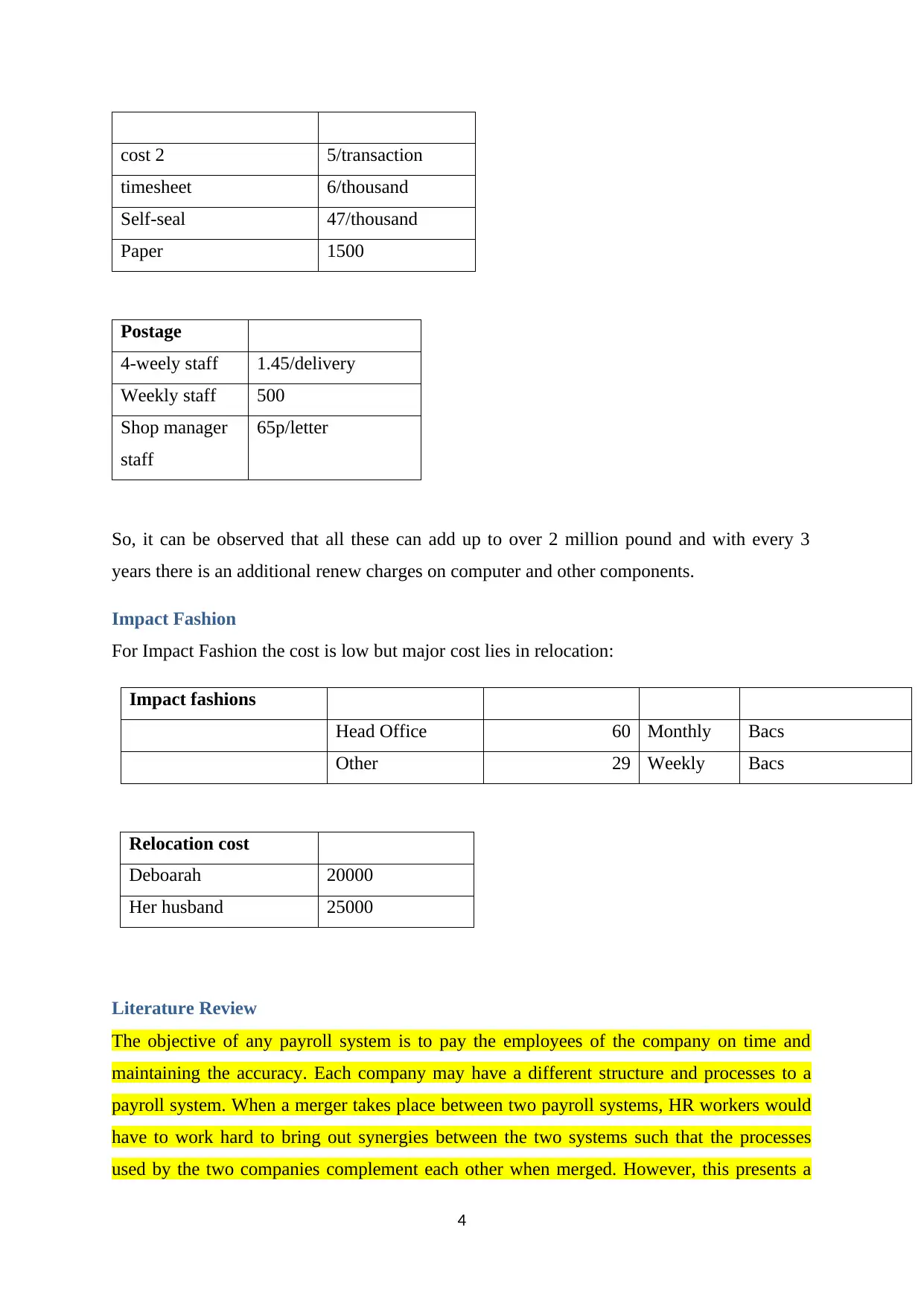
cost 2 5/transaction
timesheet 6/thousand
Self-seal 47/thousand
Paper 1500
Postage
4-weely staff 1.45/delivery
Weekly staff 500
Shop manager
staff
65p/letter
So, it can be observed that all these can add up to over 2 million pound and with every 3
years there is an additional renew charges on computer and other components.
Impact Fashion
For Impact Fashion the cost is low but major cost lies in relocation:
Impact fashions
Head Office 60 Monthly Bacs
Other 29 Weekly Bacs
Relocation cost
Deboarah 20000
Her husband 25000
Literature Review
The objective of any payroll system is to pay the employees of the company on time and
maintaining the accuracy. Each company may have a different structure and processes to a
payroll system. When a merger takes place between two payroll systems, HR workers would
have to work hard to bring out synergies between the two systems such that the processes
used by the two companies complement each other when merged. However, this presents a
4
timesheet 6/thousand
Self-seal 47/thousand
Paper 1500
Postage
4-weely staff 1.45/delivery
Weekly staff 500
Shop manager
staff
65p/letter
So, it can be observed that all these can add up to over 2 million pound and with every 3
years there is an additional renew charges on computer and other components.
Impact Fashion
For Impact Fashion the cost is low but major cost lies in relocation:
Impact fashions
Head Office 60 Monthly Bacs
Other 29 Weekly Bacs
Relocation cost
Deboarah 20000
Her husband 25000
Literature Review
The objective of any payroll system is to pay the employees of the company on time and
maintaining the accuracy. Each company may have a different structure and processes to a
payroll system. When a merger takes place between two payroll systems, HR workers would
have to work hard to bring out synergies between the two systems such that the processes
used by the two companies complement each other when merged. However, this presents a
4
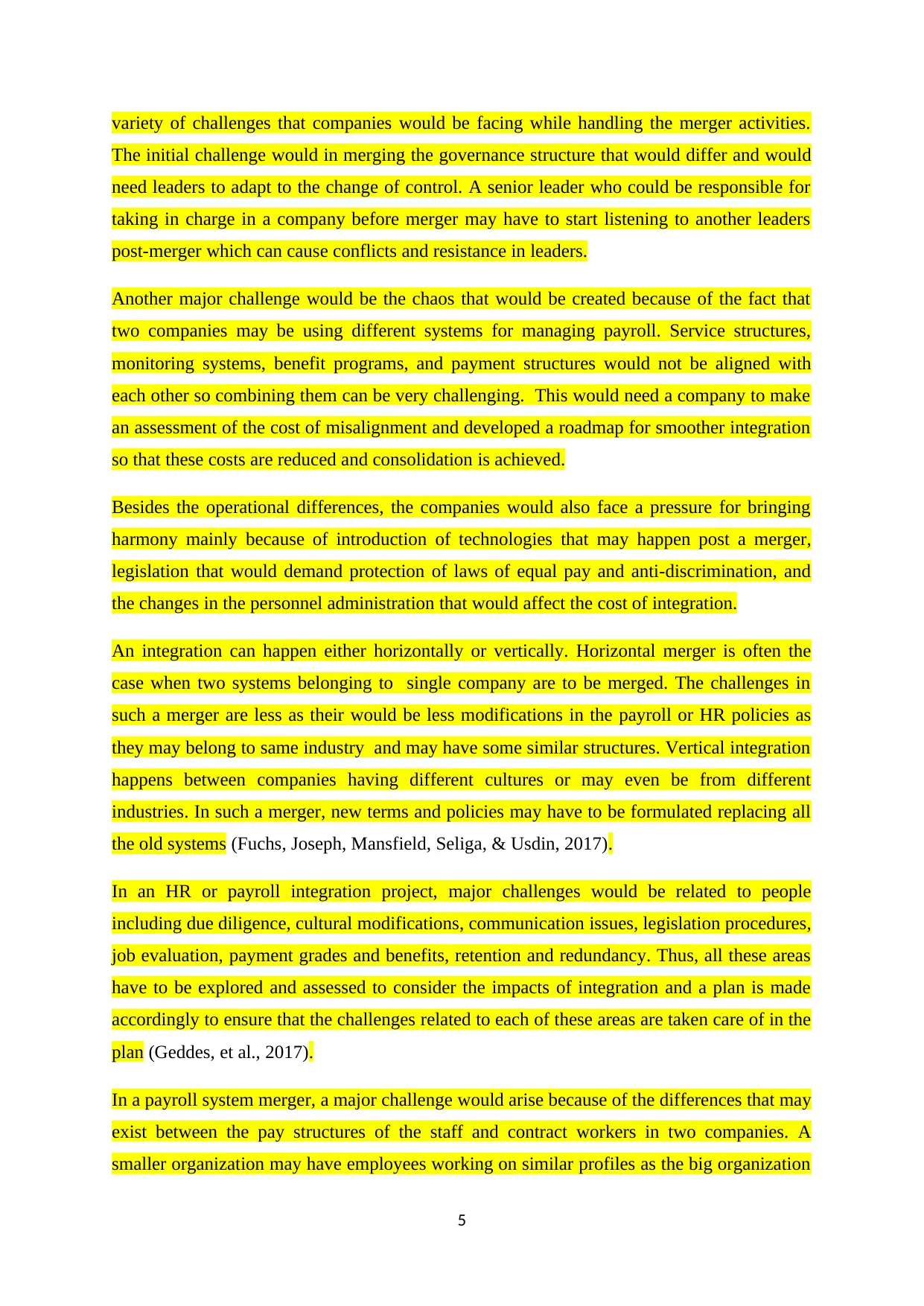
variety of challenges that companies would be facing while handling the merger activities.
The initial challenge would in merging the governance structure that would differ and would
need leaders to adapt to the change of control. A senior leader who could be responsible for
taking in charge in a company before merger may have to start listening to another leaders
post-merger which can cause conflicts and resistance in leaders.
Another major challenge would be the chaos that would be created because of the fact that
two companies may be using different systems for managing payroll. Service structures,
monitoring systems, benefit programs, and payment structures would not be aligned with
each other so combining them can be very challenging. This would need a company to make
an assessment of the cost of misalignment and developed a roadmap for smoother integration
so that these costs are reduced and consolidation is achieved.
Besides the operational differences, the companies would also face a pressure for bringing
harmony mainly because of introduction of technologies that may happen post a merger,
legislation that would demand protection of laws of equal pay and anti-discrimination, and
the changes in the personnel administration that would affect the cost of integration.
An integration can happen either horizontally or vertically. Horizontal merger is often the
case when two systems belonging to single company are to be merged. The challenges in
such a merger are less as their would be less modifications in the payroll or HR policies as
they may belong to same industry and may have some similar structures. Vertical integration
happens between companies having different cultures or may even be from different
industries. In such a merger, new terms and policies may have to be formulated replacing all
the old systems (Fuchs, Joseph, Mansfield, Seliga, & Usdin, 2017).
In an HR or payroll integration project, major challenges would be related to people
including due diligence, cultural modifications, communication issues, legislation procedures,
job evaluation, payment grades and benefits, retention and redundancy. Thus, all these areas
have to be explored and assessed to consider the impacts of integration and a plan is made
accordingly to ensure that the challenges related to each of these areas are taken care of in the
plan (Geddes, et al., 2017).
In a payroll system merger, a major challenge would arise because of the differences that may
exist between the pay structures of the staff and contract workers in two companies. A
smaller organization may have employees working on similar profiles as the big organization
5
The initial challenge would in merging the governance structure that would differ and would
need leaders to adapt to the change of control. A senior leader who could be responsible for
taking in charge in a company before merger may have to start listening to another leaders
post-merger which can cause conflicts and resistance in leaders.
Another major challenge would be the chaos that would be created because of the fact that
two companies may be using different systems for managing payroll. Service structures,
monitoring systems, benefit programs, and payment structures would not be aligned with
each other so combining them can be very challenging. This would need a company to make
an assessment of the cost of misalignment and developed a roadmap for smoother integration
so that these costs are reduced and consolidation is achieved.
Besides the operational differences, the companies would also face a pressure for bringing
harmony mainly because of introduction of technologies that may happen post a merger,
legislation that would demand protection of laws of equal pay and anti-discrimination, and
the changes in the personnel administration that would affect the cost of integration.
An integration can happen either horizontally or vertically. Horizontal merger is often the
case when two systems belonging to single company are to be merged. The challenges in
such a merger are less as their would be less modifications in the payroll or HR policies as
they may belong to same industry and may have some similar structures. Vertical integration
happens between companies having different cultures or may even be from different
industries. In such a merger, new terms and policies may have to be formulated replacing all
the old systems (Fuchs, Joseph, Mansfield, Seliga, & Usdin, 2017).
In an HR or payroll integration project, major challenges would be related to people
including due diligence, cultural modifications, communication issues, legislation procedures,
job evaluation, payment grades and benefits, retention and redundancy. Thus, all these areas
have to be explored and assessed to consider the impacts of integration and a plan is made
accordingly to ensure that the challenges related to each of these areas are taken care of in the
plan (Geddes, et al., 2017).
In a payroll system merger, a major challenge would arise because of the differences that may
exist between the pay structures of the staff and contract workers in two companies. A
smaller organization may have employees working on similar profiles as the big organization
5
⊘ This is a preview!⊘
Do you want full access?
Subscribe today to unlock all pages.

Trusted by 1+ million students worldwide
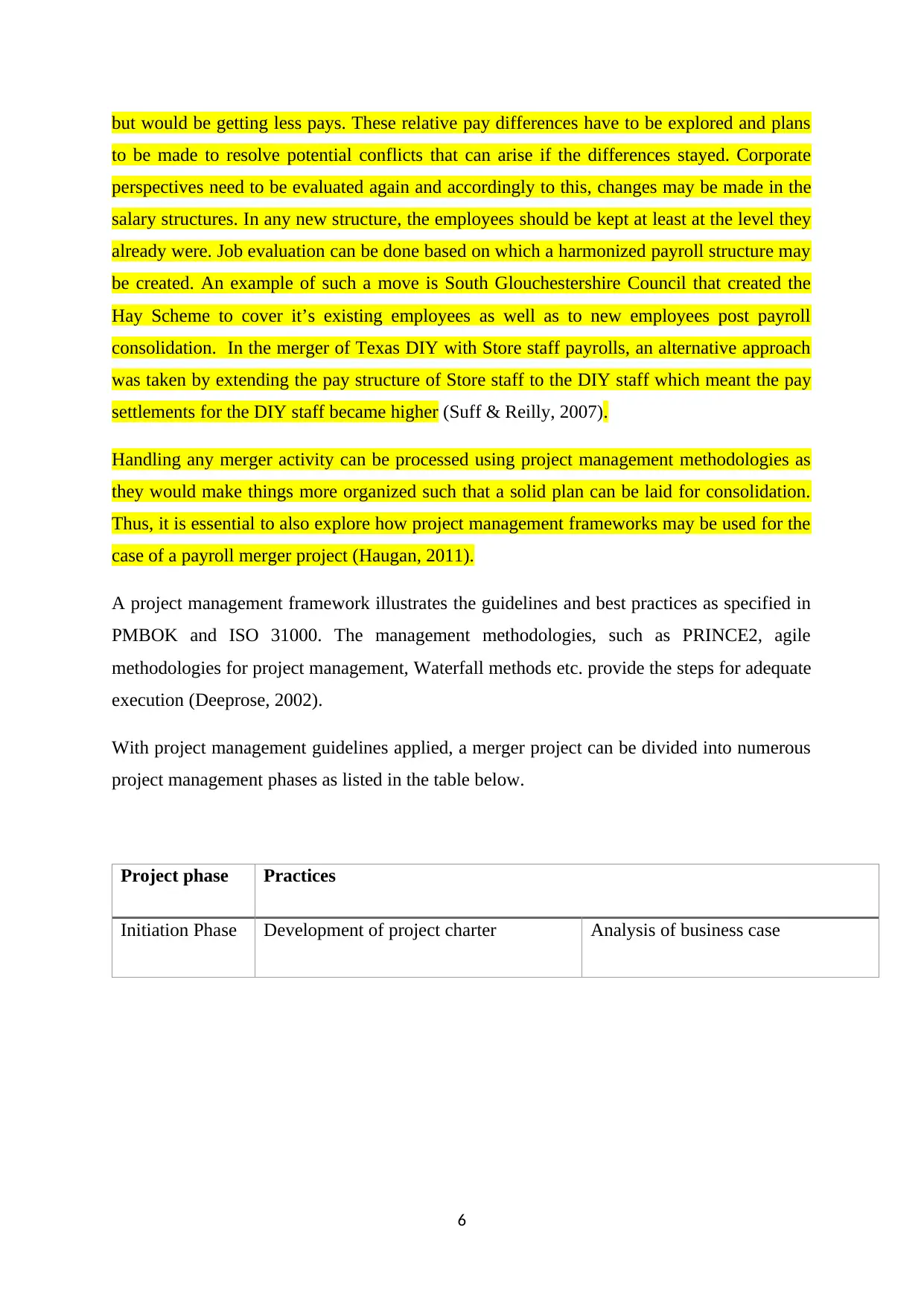
but would be getting less pays. These relative pay differences have to be explored and plans
to be made to resolve potential conflicts that can arise if the differences stayed. Corporate
perspectives need to be evaluated again and accordingly to this, changes may be made in the
salary structures. In any new structure, the employees should be kept at least at the level they
already were. Job evaluation can be done based on which a harmonized payroll structure may
be created. An example of such a move is South Glouchestershire Council that created the
Hay Scheme to cover it’s existing employees as well as to new employees post payroll
consolidation. In the merger of Texas DIY with Store staff payrolls, an alternative approach
was taken by extending the pay structure of Store staff to the DIY staff which meant the pay
settlements for the DIY staff became higher (Suff & Reilly, 2007).
Handling any merger activity can be processed using project management methodologies as
they would make things more organized such that a solid plan can be laid for consolidation.
Thus, it is essential to also explore how project management frameworks may be used for the
case of a payroll merger project (Haugan, 2011).
A project management framework illustrates the guidelines and best practices as specified in
PMBOK and ISO 31000. The management methodologies, such as PRINCE2, agile
methodologies for project management, Waterfall methods etc. provide the steps for adequate
execution (Deeprose, 2002).
With project management guidelines applied, a merger project can be divided into numerous
project management phases as listed in the table below.
Project phase Practices
Initiation Phase Development of project charter Analysis of business case
6
to be made to resolve potential conflicts that can arise if the differences stayed. Corporate
perspectives need to be evaluated again and accordingly to this, changes may be made in the
salary structures. In any new structure, the employees should be kept at least at the level they
already were. Job evaluation can be done based on which a harmonized payroll structure may
be created. An example of such a move is South Glouchestershire Council that created the
Hay Scheme to cover it’s existing employees as well as to new employees post payroll
consolidation. In the merger of Texas DIY with Store staff payrolls, an alternative approach
was taken by extending the pay structure of Store staff to the DIY staff which meant the pay
settlements for the DIY staff became higher (Suff & Reilly, 2007).
Handling any merger activity can be processed using project management methodologies as
they would make things more organized such that a solid plan can be laid for consolidation.
Thus, it is essential to also explore how project management frameworks may be used for the
case of a payroll merger project (Haugan, 2011).
A project management framework illustrates the guidelines and best practices as specified in
PMBOK and ISO 31000. The management methodologies, such as PRINCE2, agile
methodologies for project management, Waterfall methods etc. provide the steps for adequate
execution (Deeprose, 2002).
With project management guidelines applied, a merger project can be divided into numerous
project management phases as listed in the table below.
Project phase Practices
Initiation Phase Development of project charter Analysis of business case
6
Paraphrase This Document
Need a fresh take? Get an instant paraphrase of this document with our AI Paraphraser
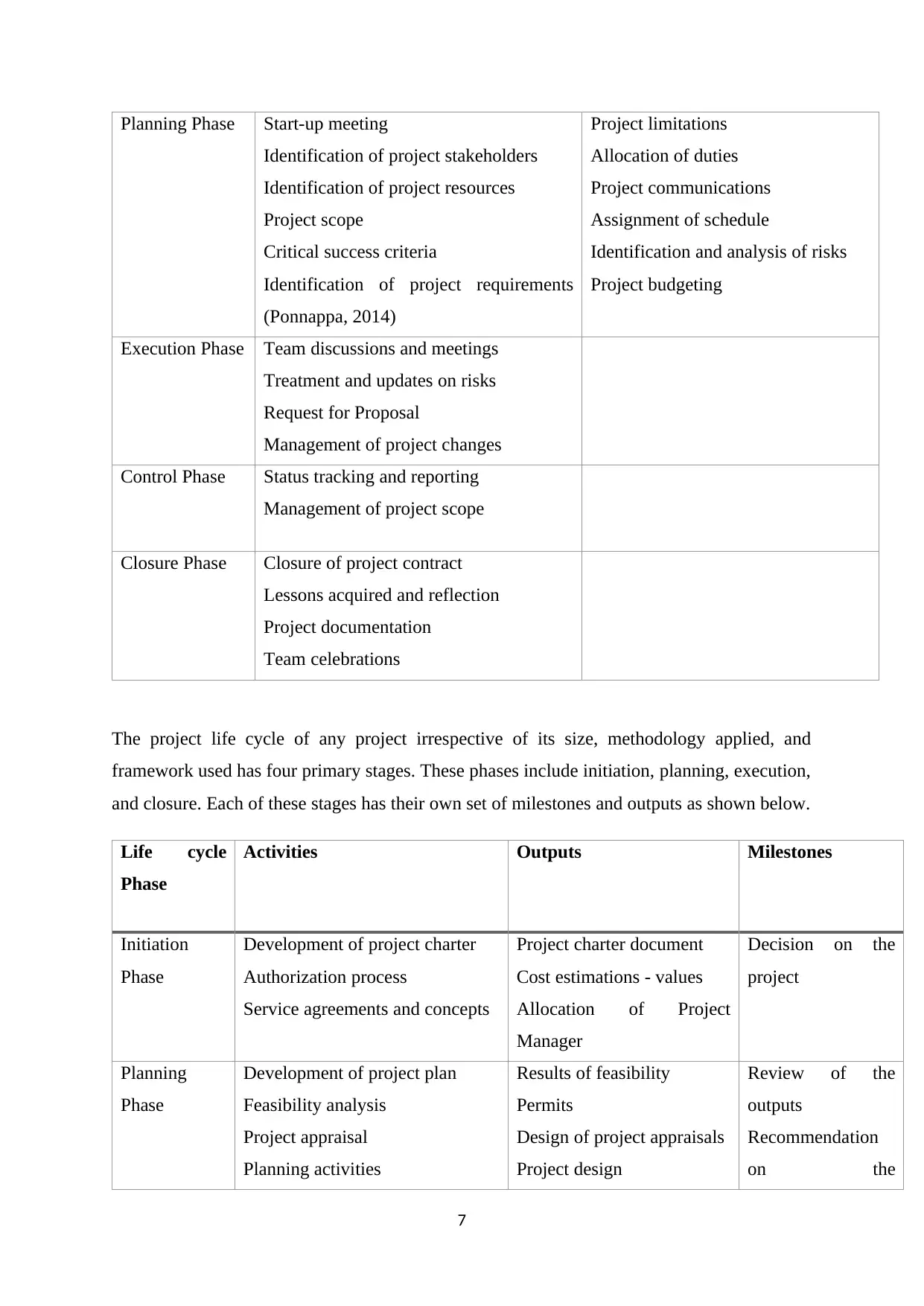
Planning Phase Start-up meeting
Identification of project stakeholders
Identification of project resources
Project scope
Critical success criteria
Identification of project requirements
(Ponnappa, 2014)
Project limitations
Allocation of duties
Project communications
Assignment of schedule
Identification and analysis of risks
Project budgeting
Execution Phase Team discussions and meetings
Treatment and updates on risks
Request for Proposal
Management of project changes
Control Phase Status tracking and reporting
Management of project scope
Closure Phase Closure of project contract
Lessons acquired and reflection
Project documentation
Team celebrations
The project life cycle of any project irrespective of its size, methodology applied, and
framework used has four primary stages. These phases include initiation, planning, execution,
and closure. Each of these stages has their own set of milestones and outputs as shown below.
Life cycle
Phase
Activities Outputs Milestones
Initiation
Phase
Development of project charter
Authorization process
Service agreements and concepts
Project charter document
Cost estimations - values
Allocation of Project
Manager
Decision on the
project
Planning
Phase
Development of project plan
Feasibility analysis
Project appraisal
Planning activities
Results of feasibility
Permits
Design of project appraisals
Project design
Review of the
outputs
Recommendation
on the
7
Identification of project stakeholders
Identification of project resources
Project scope
Critical success criteria
Identification of project requirements
(Ponnappa, 2014)
Project limitations
Allocation of duties
Project communications
Assignment of schedule
Identification and analysis of risks
Project budgeting
Execution Phase Team discussions and meetings
Treatment and updates on risks
Request for Proposal
Management of project changes
Control Phase Status tracking and reporting
Management of project scope
Closure Phase Closure of project contract
Lessons acquired and reflection
Project documentation
Team celebrations
The project life cycle of any project irrespective of its size, methodology applied, and
framework used has four primary stages. These phases include initiation, planning, execution,
and closure. Each of these stages has their own set of milestones and outputs as shown below.
Life cycle
Phase
Activities Outputs Milestones
Initiation
Phase
Development of project charter
Authorization process
Service agreements and concepts
Project charter document
Cost estimations - values
Allocation of Project
Manager
Decision on the
project
Planning
Phase
Development of project plan
Feasibility analysis
Project appraisal
Planning activities
Results of feasibility
Permits
Design of project appraisals
Project design
Review of the
outputs
Recommendation
on the
7
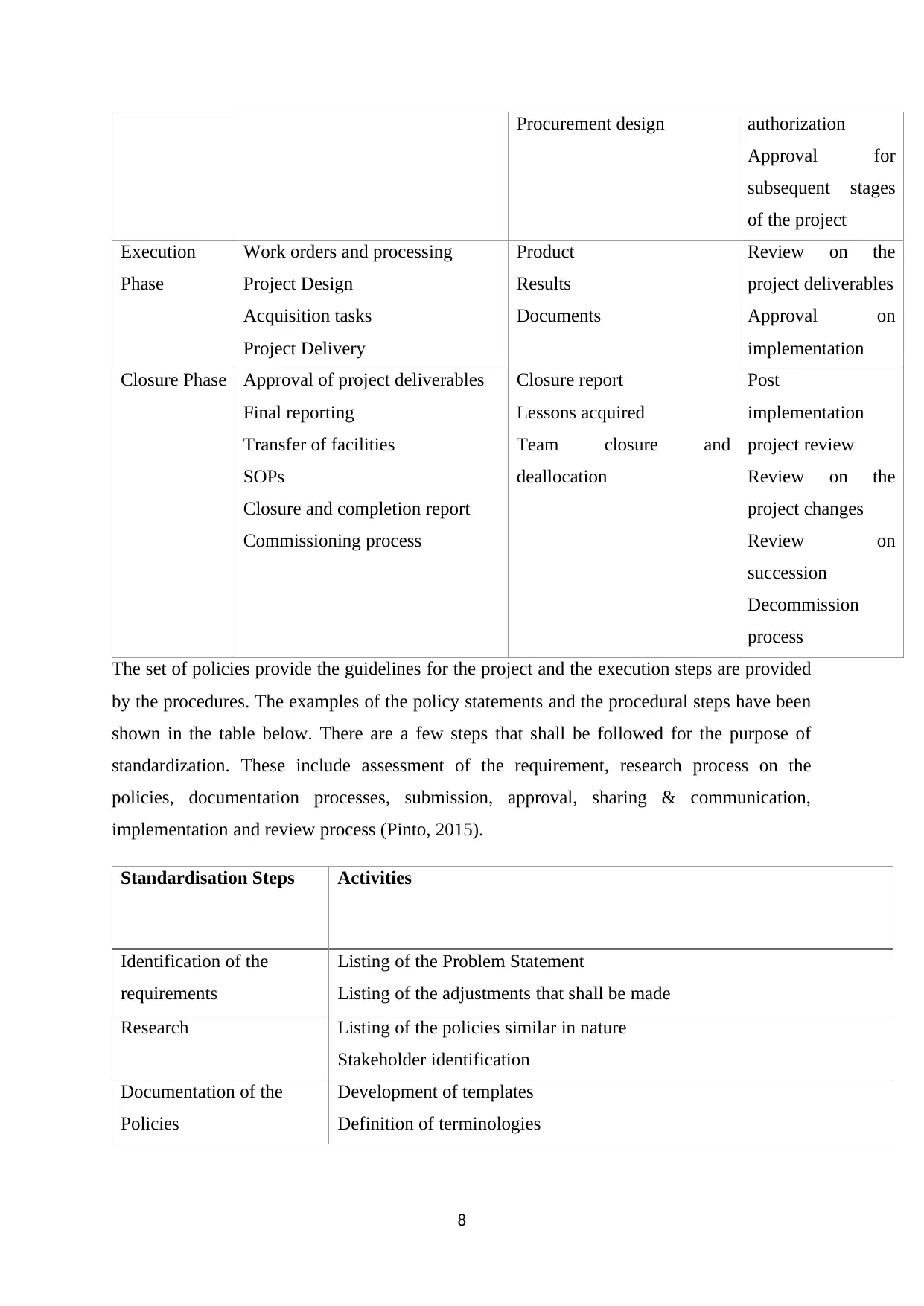
Procurement design authorization
Approval for
subsequent stages
of the project
Execution
Phase
Work orders and processing
Project Design
Acquisition tasks
Project Delivery
Product
Results
Documents
Review on the
project deliverables
Approval on
implementation
Closure Phase Approval of project deliverables
Final reporting
Transfer of facilities
SOPs
Closure and completion report
Commissioning process
Closure report
Lessons acquired
Team closure and
deallocation
Post
implementation
project review
Review on the
project changes
Review on
succession
Decommission
process
The set of policies provide the guidelines for the project and the execution steps are provided
by the procedures. The examples of the policy statements and the procedural steps have been
shown in the table below. There are a few steps that shall be followed for the purpose of
standardization. These include assessment of the requirement, research process on the
policies, documentation processes, submission, approval, sharing & communication,
implementation and review process (Pinto, 2015).
Standardisation Steps Activities
Identification of the
requirements
Listing of the Problem Statement
Listing of the adjustments that shall be made
Research Listing of the policies similar in nature
Stakeholder identification
Documentation of the
Policies
Development of templates
Definition of terminologies
8
Approval for
subsequent stages
of the project
Execution
Phase
Work orders and processing
Project Design
Acquisition tasks
Project Delivery
Product
Results
Documents
Review on the
project deliverables
Approval on
implementation
Closure Phase Approval of project deliverables
Final reporting
Transfer of facilities
SOPs
Closure and completion report
Commissioning process
Closure report
Lessons acquired
Team closure and
deallocation
Post
implementation
project review
Review on the
project changes
Review on
succession
Decommission
process
The set of policies provide the guidelines for the project and the execution steps are provided
by the procedures. The examples of the policy statements and the procedural steps have been
shown in the table below. There are a few steps that shall be followed for the purpose of
standardization. These include assessment of the requirement, research process on the
policies, documentation processes, submission, approval, sharing & communication,
implementation and review process (Pinto, 2015).
Standardisation Steps Activities
Identification of the
requirements
Listing of the Problem Statement
Listing of the adjustments that shall be made
Research Listing of the policies similar in nature
Stakeholder identification
Documentation of the
Policies
Development of templates
Definition of terminologies
8
⊘ This is a preview!⊘
Do you want full access?
Subscribe today to unlock all pages.

Trusted by 1+ million students worldwide
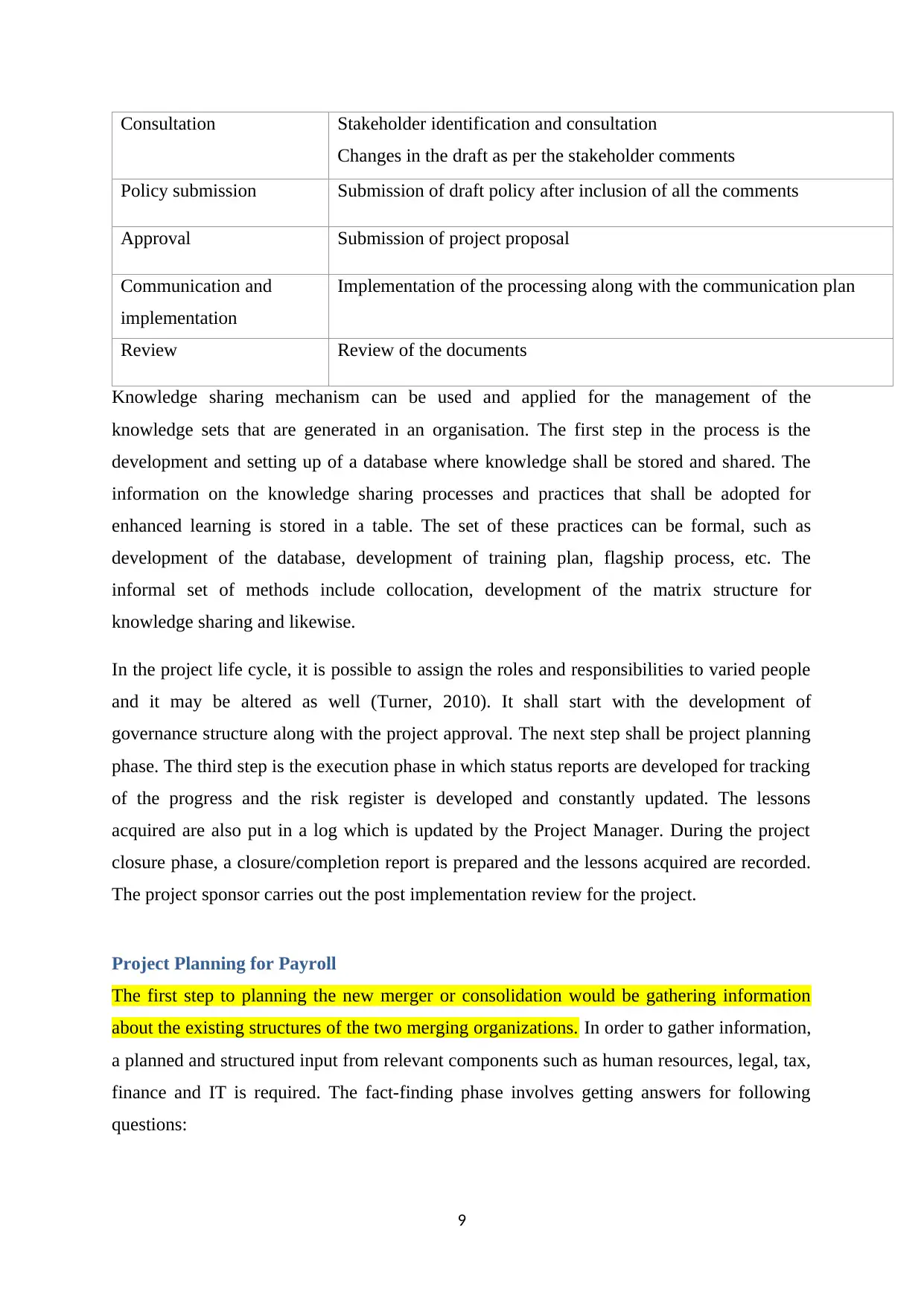
Consultation Stakeholder identification and consultation
Changes in the draft as per the stakeholder comments
Policy submission Submission of draft policy after inclusion of all the comments
Approval Submission of project proposal
Communication and
implementation
Implementation of the processing along with the communication plan
Review Review of the documents
Knowledge sharing mechanism can be used and applied for the management of the
knowledge sets that are generated in an organisation. The first step in the process is the
development and setting up of a database where knowledge shall be stored and shared. The
information on the knowledge sharing processes and practices that shall be adopted for
enhanced learning is stored in a table. The set of these practices can be formal, such as
development of the database, development of training plan, flagship process, etc. The
informal set of methods include collocation, development of the matrix structure for
knowledge sharing and likewise.
In the project life cycle, it is possible to assign the roles and responsibilities to varied people
and it may be altered as well (Turner, 2010). It shall start with the development of
governance structure along with the project approval. The next step shall be project planning
phase. The third step is the execution phase in which status reports are developed for tracking
of the progress and the risk register is developed and constantly updated. The lessons
acquired are also put in a log which is updated by the Project Manager. During the project
closure phase, a closure/completion report is prepared and the lessons acquired are recorded.
The project sponsor carries out the post implementation review for the project.
Project Planning for Payroll
The first step to planning the new merger or consolidation would be gathering information
about the existing structures of the two merging organizations. In order to gather information,
a planned and structured input from relevant components such as human resources, legal, tax,
finance and IT is required. The fact-finding phase involves getting answers for following
questions:
9
Changes in the draft as per the stakeholder comments
Policy submission Submission of draft policy after inclusion of all the comments
Approval Submission of project proposal
Communication and
implementation
Implementation of the processing along with the communication plan
Review Review of the documents
Knowledge sharing mechanism can be used and applied for the management of the
knowledge sets that are generated in an organisation. The first step in the process is the
development and setting up of a database where knowledge shall be stored and shared. The
information on the knowledge sharing processes and practices that shall be adopted for
enhanced learning is stored in a table. The set of these practices can be formal, such as
development of the database, development of training plan, flagship process, etc. The
informal set of methods include collocation, development of the matrix structure for
knowledge sharing and likewise.
In the project life cycle, it is possible to assign the roles and responsibilities to varied people
and it may be altered as well (Turner, 2010). It shall start with the development of
governance structure along with the project approval. The next step shall be project planning
phase. The third step is the execution phase in which status reports are developed for tracking
of the progress and the risk register is developed and constantly updated. The lessons
acquired are also put in a log which is updated by the Project Manager. During the project
closure phase, a closure/completion report is prepared and the lessons acquired are recorded.
The project sponsor carries out the post implementation review for the project.
Project Planning for Payroll
The first step to planning the new merger or consolidation would be gathering information
about the existing structures of the two merging organizations. In order to gather information,
a planned and structured input from relevant components such as human resources, legal, tax,
finance and IT is required. The fact-finding phase involves getting answers for following
questions:
9
Paraphrase This Document
Need a fresh take? Get an instant paraphrase of this document with our AI Paraphraser
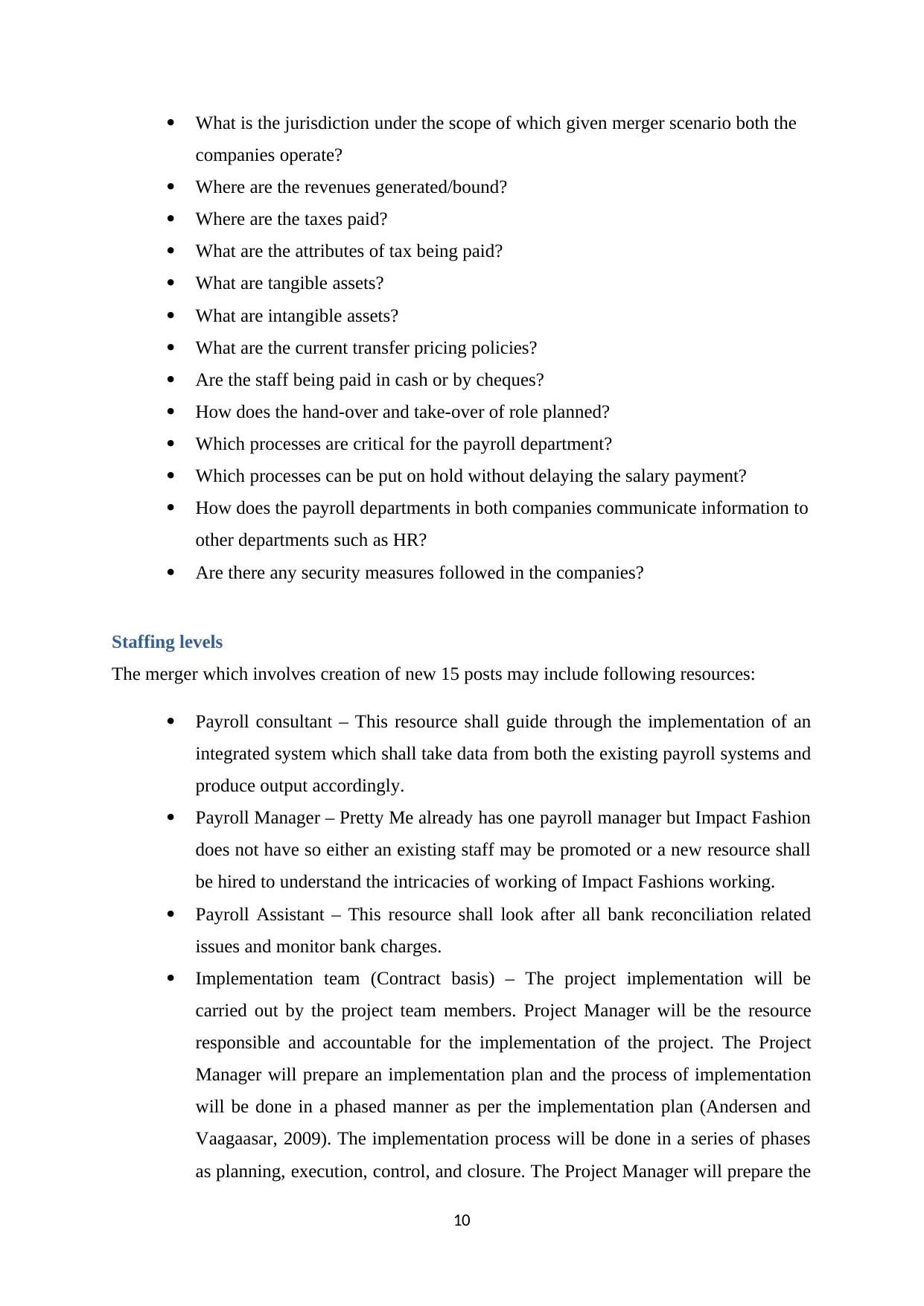
What is the jurisdiction under the scope of which given merger scenario both the
companies operate?
Where are the revenues generated/bound?
Where are the taxes paid?
What are the attributes of tax being paid?
What are tangible assets?
What are intangible assets?
What are the current transfer pricing policies?
Are the staff being paid in cash or by cheques?
How does the hand-over and take-over of role planned?
Which processes are critical for the payroll department?
Which processes can be put on hold without delaying the salary payment?
How does the payroll departments in both companies communicate information to
other departments such as HR?
Are there any security measures followed in the companies?
Staffing levels
The merger which involves creation of new 15 posts may include following resources:
Payroll consultant – This resource shall guide through the implementation of an
integrated system which shall take data from both the existing payroll systems and
produce output accordingly.
Payroll Manager – Pretty Me already has one payroll manager but Impact Fashion
does not have so either an existing staff may be promoted or a new resource shall
be hired to understand the intricacies of working of Impact Fashions working.
Payroll Assistant – This resource shall look after all bank reconciliation related
issues and monitor bank charges.
Implementation team (Contract basis) – The project implementation will be
carried out by the project team members. Project Manager will be the resource
responsible and accountable for the implementation of the project. The Project
Manager will prepare an implementation plan and the process of implementation
will be done in a phased manner as per the implementation plan (Andersen and
Vaagaasar, 2009). The implementation process will be done in a series of phases
as planning, execution, control, and closure. The Project Manager will prepare the
10
companies operate?
Where are the revenues generated/bound?
Where are the taxes paid?
What are the attributes of tax being paid?
What are tangible assets?
What are intangible assets?
What are the current transfer pricing policies?
Are the staff being paid in cash or by cheques?
How does the hand-over and take-over of role planned?
Which processes are critical for the payroll department?
Which processes can be put on hold without delaying the salary payment?
How does the payroll departments in both companies communicate information to
other departments such as HR?
Are there any security measures followed in the companies?
Staffing levels
The merger which involves creation of new 15 posts may include following resources:
Payroll consultant – This resource shall guide through the implementation of an
integrated system which shall take data from both the existing payroll systems and
produce output accordingly.
Payroll Manager – Pretty Me already has one payroll manager but Impact Fashion
does not have so either an existing staff may be promoted or a new resource shall
be hired to understand the intricacies of working of Impact Fashions working.
Payroll Assistant – This resource shall look after all bank reconciliation related
issues and monitor bank charges.
Implementation team (Contract basis) – The project implementation will be
carried out by the project team members. Project Manager will be the resource
responsible and accountable for the implementation of the project. The Project
Manager will prepare an implementation plan and the process of implementation
will be done in a phased manner as per the implementation plan (Andersen and
Vaagaasar, 2009). The implementation process will be done in a series of phases
as planning, execution, control, and closure. The Project Manager will prepare the
10
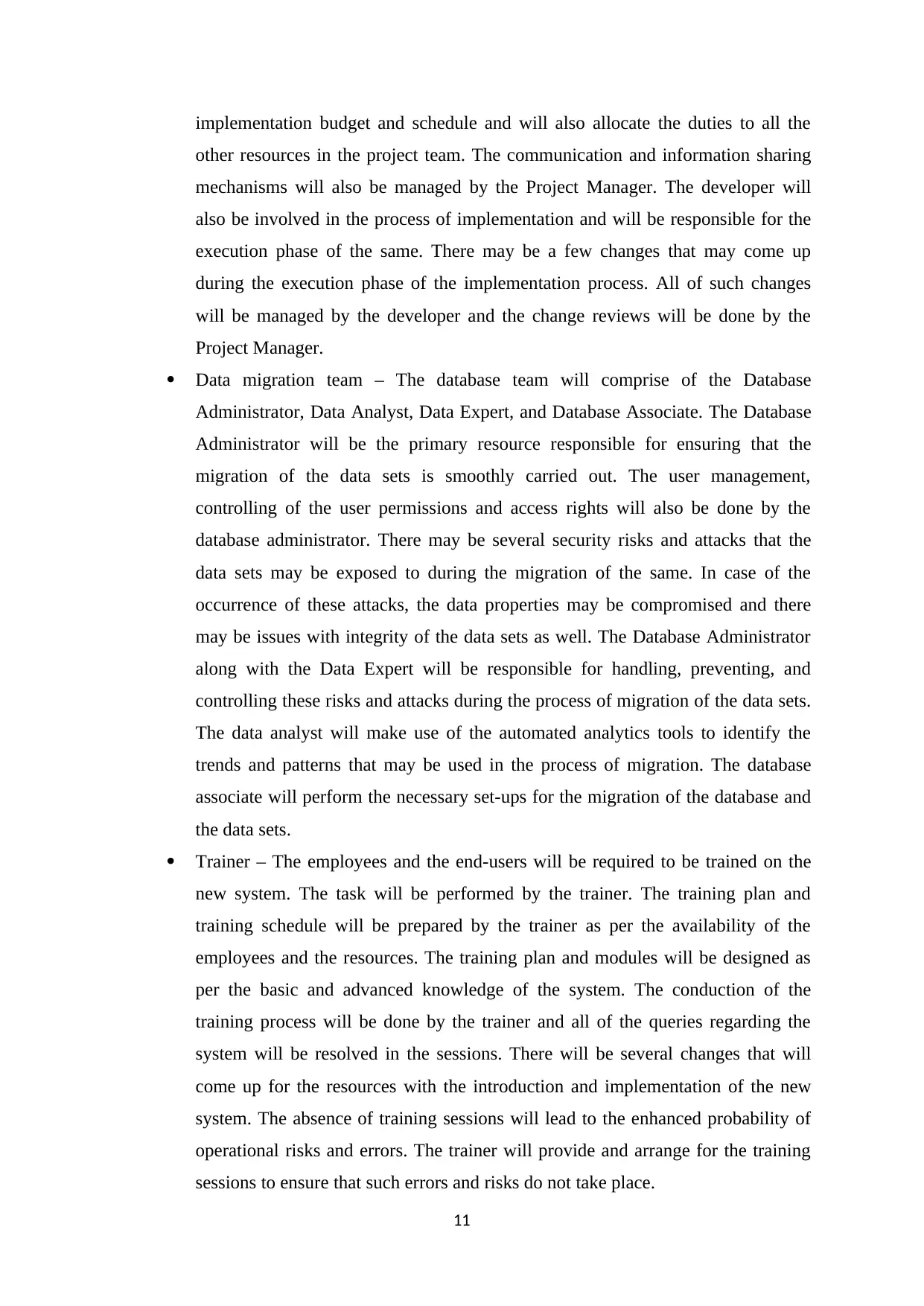
implementation budget and schedule and will also allocate the duties to all the
other resources in the project team. The communication and information sharing
mechanisms will also be managed by the Project Manager. The developer will
also be involved in the process of implementation and will be responsible for the
execution phase of the same. There may be a few changes that may come up
during the execution phase of the implementation process. All of such changes
will be managed by the developer and the change reviews will be done by the
Project Manager.
Data migration team – The database team will comprise of the Database
Administrator, Data Analyst, Data Expert, and Database Associate. The Database
Administrator will be the primary resource responsible for ensuring that the
migration of the data sets is smoothly carried out. The user management,
controlling of the user permissions and access rights will also be done by the
database administrator. There may be several security risks and attacks that the
data sets may be exposed to during the migration of the same. In case of the
occurrence of these attacks, the data properties may be compromised and there
may be issues with integrity of the data sets as well. The Database Administrator
along with the Data Expert will be responsible for handling, preventing, and
controlling these risks and attacks during the process of migration of the data sets.
The data analyst will make use of the automated analytics tools to identify the
trends and patterns that may be used in the process of migration. The database
associate will perform the necessary set-ups for the migration of the database and
the data sets.
Trainer – The employees and the end-users will be required to be trained on the
new system. The task will be performed by the trainer. The training plan and
training schedule will be prepared by the trainer as per the availability of the
employees and the resources. The training plan and modules will be designed as
per the basic and advanced knowledge of the system. The conduction of the
training process will be done by the trainer and all of the queries regarding the
system will be resolved in the sessions. There will be several changes that will
come up for the resources with the introduction and implementation of the new
system. The absence of training sessions will lead to the enhanced probability of
operational risks and errors. The trainer will provide and arrange for the training
sessions to ensure that such errors and risks do not take place.
11
other resources in the project team. The communication and information sharing
mechanisms will also be managed by the Project Manager. The developer will
also be involved in the process of implementation and will be responsible for the
execution phase of the same. There may be a few changes that may come up
during the execution phase of the implementation process. All of such changes
will be managed by the developer and the change reviews will be done by the
Project Manager.
Data migration team – The database team will comprise of the Database
Administrator, Data Analyst, Data Expert, and Database Associate. The Database
Administrator will be the primary resource responsible for ensuring that the
migration of the data sets is smoothly carried out. The user management,
controlling of the user permissions and access rights will also be done by the
database administrator. There may be several security risks and attacks that the
data sets may be exposed to during the migration of the same. In case of the
occurrence of these attacks, the data properties may be compromised and there
may be issues with integrity of the data sets as well. The Database Administrator
along with the Data Expert will be responsible for handling, preventing, and
controlling these risks and attacks during the process of migration of the data sets.
The data analyst will make use of the automated analytics tools to identify the
trends and patterns that may be used in the process of migration. The database
associate will perform the necessary set-ups for the migration of the database and
the data sets.
Trainer – The employees and the end-users will be required to be trained on the
new system. The task will be performed by the trainer. The training plan and
training schedule will be prepared by the trainer as per the availability of the
employees and the resources. The training plan and modules will be designed as
per the basic and advanced knowledge of the system. The conduction of the
training process will be done by the trainer and all of the queries regarding the
system will be resolved in the sessions. There will be several changes that will
come up for the resources with the introduction and implementation of the new
system. The absence of training sessions will lead to the enhanced probability of
operational risks and errors. The trainer will provide and arrange for the training
sessions to ensure that such errors and risks do not take place.
11
⊘ This is a preview!⊘
Do you want full access?
Subscribe today to unlock all pages.

Trusted by 1+ million students worldwide
1 out of 24
Related Documents
Your All-in-One AI-Powered Toolkit for Academic Success.
+13062052269
info@desklib.com
Available 24*7 on WhatsApp / Email
![[object Object]](/_next/static/media/star-bottom.7253800d.svg)
Unlock your academic potential
Copyright © 2020–2025 A2Z Services. All Rights Reserved. Developed and managed by ZUCOL.




